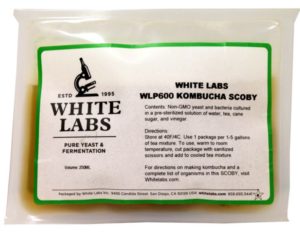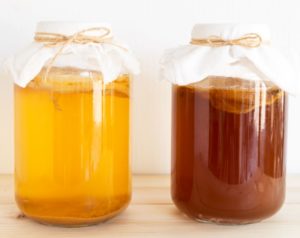If you’re familiar with the term “kombucha” it’s probably because you’ve heard how this fermented tea drink is creating a serious commotion in the world of home brewing. This is in large part because apart from a nice buzz, kombucha also provides some amazing health benefits. It contains a variety of antioxidants that help keep your cells healthy and probiotics which also aid in digestion.
A lot of kombucha lovers choose to make their own because it can get pretty pricey when buying it at a store. The process of home brewing is fairly easy and involves only a few key steps and ingredients.
The Importance of SCOBY When Making Kombucha
 SCOBY stands for Symbiotic Cultures of Bacteria and Yeast and it is an important part of the Kombucha brewing process (we sell White Labs Kombucha Scoby for $38.95). First, let’s address the elephant in the room: It looks like it could be the spleen of the creature from the movie Aliens. But as ugly as it is in appearance, it plays a huge role in your success of making Kombucha because it is the matter that ferments your sweet tea. While in the past using SCOBY was a trial and error process, some pretty major advancements have since been made.
SCOBY stands for Symbiotic Cultures of Bacteria and Yeast and it is an important part of the Kombucha brewing process (we sell White Labs Kombucha Scoby for $38.95). First, let’s address the elephant in the room: It looks like it could be the spleen of the creature from the movie Aliens. But as ugly as it is in appearance, it plays a huge role in your success of making Kombucha because it is the matter that ferments your sweet tea. While in the past using SCOBY was a trial and error process, some pretty major advancements have since been made.
The SCOBY produced by White Labs is the ideal choice for making Kombucha. It uses a process of genetic identification, which helps it recognize what yeast & bacteria are needed in the fermentation process. With less time spent on having to repeat the process, you can sip and enjoy your homebrewed kombucha sooner than ever before.
Obtain Your Starter Liquid
Your starter liquid is the base of your kombucha and turns the key for the bacteria to start working their magic. You can obtain starter liquid from the same place you get your kombucha. (White Labs, for example, provides both).
Time to Start Brewing
The following is a recipe to brew 1 gallon of kombucha, make sure your hands and preparation space is properly sanitized:
- 1 SCOBY
- 1-2 cups starter liquid
- 1-gallon glass jar
- Tea towel (or breathable fabric) and rubber band
- Bring 4 cups of water to a boil and add 8 unflavored, non-herbal tea bags. Let this steep for 10 minutes. Remove the tea bags after steeping, then add 1 cup of pure cane sugar and stir until it dissolves completely. (Note: You can use table sugar but we recommend cane sugar).
- At this point, you will need to carefully pour the liquid into a sterilized gallon container and fill most of the remaining space with water and let the mixture cool to room temperature.
- Gently place the SCOBY on top of the tea/water and carefully mix in the starter liquid.
- You will then need to cover the container with a clean cloth that allows air to pass through it but will prevent flies or other pests from getting at it. Secure the cloth to the container using a rubber band.
- Store your container in a space that is not exposed to sunlight, but will also not get too cold at night. Between 75 and 85 degrees, Fahrenheit is the ideal temperature.
The Waiting Game
 Here is where you need to develop your taste for Kombucha to find the right fermentation period. The window can be anywhere from 7 days to 3 weeks. So you’ll need to pop in and taste it once in a while to see how it’s coming along. Always use a sterilized straw and of course, don’t double-dip after tasting.
Here is where you need to develop your taste for Kombucha to find the right fermentation period. The window can be anywhere from 7 days to 3 weeks. So you’ll need to pop in and taste it once in a while to see how it’s coming along. Always use a sterilized straw and of course, don’t double-dip after tasting.
Once you’ve hit the right taste, you’re ready to bottle it up and enjoy it! You can start to get creative adding organic fruits or purees to the kombucha. Let your taste buds decide what’s best for you! Stop by or call anytime with questions, let us know how it goes. Happy brewing!
